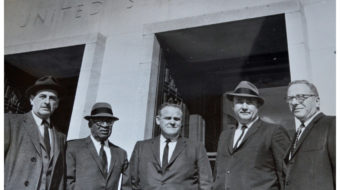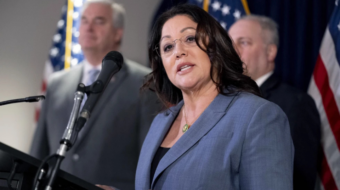
Editor’s note: President Barack Obama often says that if you “work hard and play by the rules” you deserve an opportunity to make your life and your community better. Too often employees – who are working hard and playing by the rules – wind up dead from that work. An average of 150 workers die each day in America on the job or from a work-related illness, according to a recent report by the AFL-CIO, from which the executive summary is reprinted here.
This 2013 edition of Death on the Job: The Toll of Neglect marks the 22nd year the AFL-CIO has produced a report on the state of safety and health protections for America’s workers.
More than four decades ago, in 1970, Congress enacted the Occupational Safety and Health Act, promising workers in this country the right to a safe job. Since that time, workplace safety and health conditions have improved.
But too many workers remain at serious risk of injury, illness or death as workplace tragedies continue to remind us. In 2010, the explosion at the Massey Energy Upper Big Branch mine in West Virginia-the worst coal mine disaster in 40 years-killed 29 miners, and other workplace disasters, including the BP Transocean Gulf Coast Oil rig explosion, caused widespread death and destruction as well. And a few weeks ago we witnessed the catastrophe in West, Texas, where a fire at a fertilizer distributor caused a massive explosion killing 15 people, injuring hundreds and destroying blocks of the surrounding town.
But most workplace deaths occur one at a time and receive little attention. The toll to individual workers and their families is just as great. In 2011, according to final fatality data from the Bureau of Labor Statistics, 4,693 workers were killed on the job-an average of 13 workers every day-and an estimated 50,000 died from occupational diseases. More than 3.8 million work-related injuries and illnesses were reported, but this number understates the problem. The true toll of job injuries is two to three times greater-about 7.6 million to 11.4 million job injuries and illnesses each year.
After years of steady decline, for the past three years the job fatality rate has essentially been unchanged, with a rate of 3.5/100,000 workers in 2011. Similarly, from 2010 to 2011 there was no change in the reported workplace injury and illness rate (3.5/100 workers in the private sector), indicating that greater efforts are needed if we are to make further progress in reducing job injuries and deaths.
The risk of job fatalities and injuries varies widely from state to state, in part due to the mix of industries. North Dakota led the country with the highest fatality rate (12.4 per 100,000), followed by Wyoming (11.6), Montana (11.2), Alaska (11.1) and Arkansas (8.0). The lowest state fatality rate (1.2 per 100,000) was reported in New Hampshire, followed by Rhode Island (1.5), Washington (1.9), Connecticut (2.2) and Massachusetts (2.2).
Latino workers continue to be at increased risk of job fatalities, with a fatality rate of 4.0 per 100,000 workers in 2011. There were 749 fatal injuries among Latino workers, up from 707 in 2010. Sixty-eight percent of these fatalities (512 deaths) were among workers born outside the United States. Workers who are undocumented may be at particular risk facing abuse and exploitation and fearing retaliation if they raise concerns about unsafe working conditions.
The cost of job injuries and illnesses is enormous-estimated at $250 billion to $300 billion a year. The number of workplace inspectors is woefully inadequate. The federal Occupational Safety and Health Administration (OSHA) and the state OSHA plans have a total of 1,938 inspectors (873 federal and 1,065 state inspectors) to inspect the 8 million workplaces under the OSH Act’s jurisdiction. Federal OSHA can inspect workplaces on average once every 131 years; the state OSHA plans can inspect them once every 76 years. The current level of federal and state OSHA inspectors provides one inspector for every 66,776 workers. OSHA penalties are too low to deter violations. The average penalty for a serious violation of the law in FY 2012 was $2,156 for federal OSHA and $974 for the state plans.
Even in cases of worker fatalities, penalties are very weak. For FY 2012, the median initial total penalty in fatality cases investigated by federal OSHA was $6,625, with a median penalty after settlement of $5,175. For the OSHA state plans, the initial median total penalty was $4,900, reduced to $4,200 after settlement. Oregon had the lowest median current penalty for fatality investigations, with $975 in penalties assessed, followed by Utah ($1,250) and South Carolina ($1,344). South Dakota had the highest median current penalty ($70,000), followed by Hawaii ($32,454) and Minnesota ($27,730).
Criminal penalties under the OSHA law are weak. They are limited to cases in which a willful violation results in a worker death and are misdemeanors. Since 1970, only 84 cases have been prosecuted, with defendants serving a total of 89 months in jail. During this time there were more than 390,000 worker deaths. By comparison, in FY 2012 there were 320 criminal enforcement cases initiated under federal environmental laws and 231 defendants charged, resulting in 79 years of jail time and $44 million in penalties-more cases, fines and jail time in one year than during OSHA’s entire history.
After eight years of neglect and inaction under the Bush administration, the Obama administration has returned OSHA and the Mine Safety and Health Administration (MSHA) to their missions to protect workers’ safety and health, appointing strong, pro-worker safety and health advocates to head the agencies, and increasing funding and staffing.
Both OSHA and MSHA have stepped up enforcement, particularly for employers who have a history of serious, repeated and willful violations, and strengthened whistleblower programs to protect workers who report job injuries or hazards from retaliation.
But since the election of a Republican majority in the House of Representatives in 2010, progress in safety and health has been threatened. Business groups and Republicans have launched a major assault on regulations and have targeted key OSHA and MSHA rules.
In the face of these attacks, progress on developing and issuing many important safety and health rules has stalled, particularly at OSHA.
The Office of Management and Budget (OMB), which is responsible for reviewing draft rules, has been blocking needed protections, including OSHA’s draft proposed rule on silica, which has been held by OMB for more than two years. As a result, at the end of its first term, the Obama administration had issued fewer major OSHA rules than were issued by the Bush administration.
Workers in the United States need more safety and health protection, not less. Four decades after the passage of OSHA, there is much more work to be done.
The tragedy at Massey Energy’s Big Branch Mine and other workplace tragedies highlighted serious problems in job safety protections and laws. MSHA has no subpoena authority to request information from mine operators and only limited authority to shut down dangerous mines. At OSHA, the agency has no authority to require the correction of hazards while employer contests of violations are pending.
The job safety laws need to be strengthened.
Improvements in the Mine Safety and Health Act are needed to give MSHA more authority to enhance enforcement against repeated violators and to shut down dangerous mines.
The Occupational Safety and Health Act is now more than 40 years old and is out of date.
Congress should pass the Protecting America’s Workers Act to extend the law’s coverage to workers currently excluded, strengthen civil and criminal penalties for violations, enhance anti-discrimination protections and strengthen the rights of workers, unions, and victims.
The nation must renew the commitment to protect workers from injury, disease and death and make this a high priority. Employers must meet their responsibilities to protect workers and be held accountable if they put workers in danger. Only then can the promise of safe jobs for all of America’s workers be fulfilled.
Photo: A miner’s boots, helmet, and gloves at a memorial for the 29 miners who died in an explosion at Massey Energy Co.’s Upper Big Branch mine in Montcoal, W.Va. Amy Sancetta/AP










